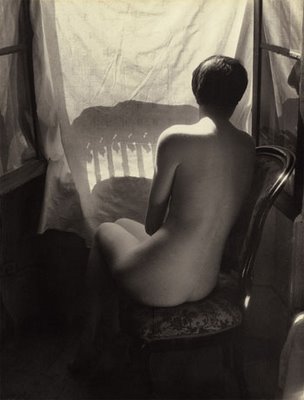
Willy Ronis, Deena de dos, Galerie Camera Obscura
Willy Ronis was born in Paris in 1910. He studied drawing, violin, harmony and a little of the law. He received his first camera in 1926 and began to photograph Paris. In 1932, he gave up his vocation as a musician to enter his father’s photographic studio. Upon the death of his father, he began to work as an independent reporter-illustrator. He published his first social subjects in the magazine Regards. In 1937 he bought his first Rolleiflex, met Robert Capa and David Seymour. His first exhibition “Neige dans les Vosges” (“Snow in the Vosges”) at Gare de l’Est in Paris was followed by “Paris la nuit” (“Paris by night”). He photographed the Citroen automobile strike in 1938. During the war, he did a variety of jobs, among them painting on jewelry with Marie-Anne whom he married in 1946. He then joined Rapho agency. His photos were published in various magazines, and he won several awards, among them the Kodak Prize and a gold medal at the Venice Biennale in 1947. He began to photograph in the Belleville and Ménilmontant districts of Paris. His book on these two districts, first published in 1954 by Artaud was reedited three times. A fourth edition was published in 1999 by Hoëbeke with a text by Didier Daeninckx. His biographer, Bertrand Eveno, has written about this book. “This cult book on an unknown district of Paris which had been very little photographed at the time expresses a populism close to that of his friend Doisneau….and reproduces the graphic force of the urban landscapes unique to Paris.”
In 1965 he was a part of the collective exhibition “Six photographes et Paris” (“Six photographers and Paris” at the Decorative Arts Museum (Musée des Arts Décoratifs) along with Robert Doisneau, Frasnay, Lattès, Pic and Janine Niepce. He taught at the schools of I.D.H.E.C., Estienne and Vaugirard, traveled through-out the Eastern block countries, Berlin, Prague, Moscow. An exhibition of this work, “Images de la RDA” (“Images of GDR”) took place in 1967-68.
He left Paris in 1972 to live in Isle-sur-la-Sorgue in the Vaucluse region of France where he taught photography at the Avignon Fine Arts College (Beaux-Arts) as well as in Aix-en –Provence and Marseilles. In 1975, he was named president of honor by the National Association of Photographer Reporters Illustrators, succeeding Brassaï. He was honored by the Grand Prize of Arts and Letters for Photography in 1979. In 1980, he was the guest of honor of the 11th International Photography Festival (Rencontres Internationales de la Photographie) in Arles. He won the Nadar Prize for his book “Sur le fil du hasard” (“On the chance’s edge”) published by Editions Contrejour Editions and exhibited his work at the Chateau d’Eau Gallery in Toulouse. Patrick Barbéris made a full-length film about him in 1982, “Un voyage de Rose” with Guy le Querrec.
In 1983, he donated his work to France, to take effect after his death. “Mon Paris” with 170 photos was published in 1985 by Denoël, the same year as a retrospective of his work was held at the Palais de Tokyo. That year he was also named as commander in the Order of Arts and Letters.
Between 1986 and 1989 he exhibited his work in New York, Moscow and Bologna. During that same time, Patrice Noïa made a 26 minute documentary about him, “Willy Ronis ou les cadeaux du hasard” (“Willy Ronis or the gifts of chance”), and he was named chevalier de Legion of Honor. Beginning in 1990, 12 of his exhibitions were shown in France and around the world.
He has since published a great number of books: a Photo poche at the National Center of Photography, “Quand je serai grand…” (“When I grow up…”) with Hors Collection, “Autoportraits” by Fata Morgana, “Les sorties du dimanche” (“Going out on Sunday”) published by Nathan, “Toutes Belles” (“All Beautiful”) published by Hoëbeke with a text by Régine Desforges, “Les enfants de Germinal” (“Germinal’s children”) in collaboration with Jean Philippe Charbonnier and Robert Doisneau, “A nous la vie !” (“Life is for us”) text by Didier Daeninckx, “Vivement Noël” and finally “la Provence” text by Edmonde Charles Roux.
He became a member of the famous London Royal Photographic Society and in 1994 exhibited “Mes années 80” (“My 80 years”) at the Hôtel de Sully in Paris, followed in 1995 by “70 ans de déclics 1926-1995” (“70 years of clicking”) at the Oxford Museum of Modern Art, then at the Pavillon des Arts in Paris in 1996, with 240 photos.
In 2001, he donated his photos for the album “Pour la Liberté de la Presse” (“For press Freedom”) put out by Reporters without Borders, with a preface by Bertrand Poirot-Delpech. He published “Derrière l’objectif, photos et propos (“Behind the lens”) with photos et text signed by him, published by Hoëbeke. He was named commander of the National Order of Merit.
In 2002, a retrospective de 150 of his photos was shown at the Municipal Library in Lyon, and Phaidon publisher published a book on him in the series “55.” From 2003 to now (end of 2005), a documentary film by Michel Toutain and Georges Chatain was made about him, “Willy Ronis autoportrait d’un photographe” (2003), his exhibitions have been travelling in France and abroad (Madrid in Spain, Verona in Italy) and 4 books were published “Willy Ronis, le Val et les bords de Marne” published by Terre Bleue (2004), “Willy Ronis, la vie en passant” published by Prestel, “Willy Ronis, Instants dérobés” published by Taschen (2005) and “Paris éternellement” published by Hoebeke (2005).
REGRESAR A LA REVISTA









